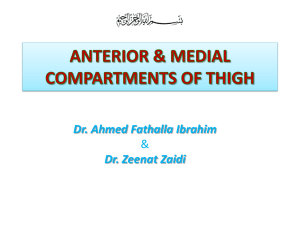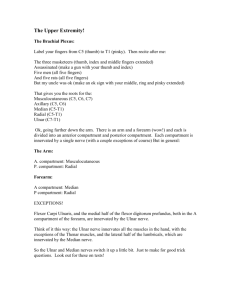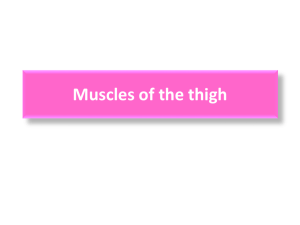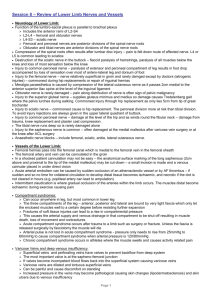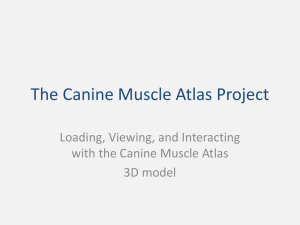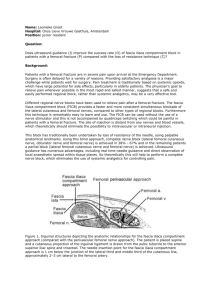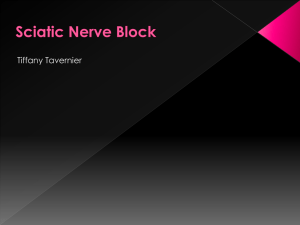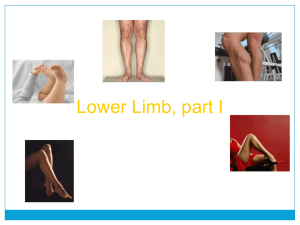Lower Extremity
advertisement
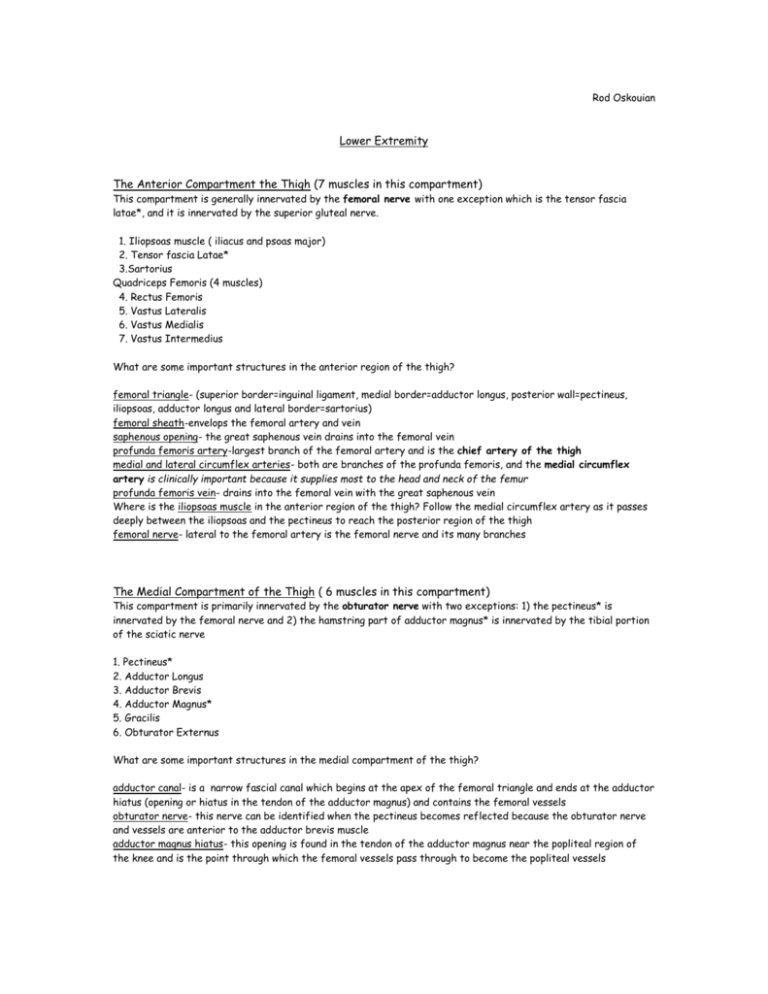
Rod Oskouian Lower Extremity The Anterior Compartment the Thigh (7 muscles in this compartment) This compartment is generally innervated by the femoral nerve with one exception which is the tensor fascia latae*, and it is innervated by the superior gluteal nerve. 1. Iliopsoas muscle ( iliacus and psoas major) 2. Tensor fascia Latae* 3.Sartorius Quadriceps Femoris (4 muscles) 4. Rectus Femoris 5. Vastus Lateralis 6. Vastus Medialis 7. Vastus Intermedius What are some important structures in the anterior region of the thigh? femoral triangle- (superior border=inguinal ligament, medial border=adductor longus, posterior wall=pectineus, iliopsoas, adductor longus and lateral border=sartorius) femoral sheath-envelops the femoral artery and vein saphenous opening- the great saphenous vein drains into the femoral vein profunda femoris artery-largest branch of the femoral artery and is the chief artery of the thigh medial and lateral circumflex arteries- both are branches of the profunda femoris, and the medial circumflex artery is clinically important because it supplies most to the head and neck of the femur profunda femoris vein- drains into the femoral vein with the great saphenous vein Where is the iliopsoas muscle in the anterior region of the thigh? Follow the medial circumflex artery as it passes deeply between the iliopsoas and the pectineus to reach the posterior region of the thigh femoral nerve- lateral to the femoral artery is the femoral nerve and its many branches The Medial Compartment of the Thigh ( 6 muscles in this compartment) This compartment is primarily innervated by the obturator nerve with two exceptions: 1) the pectineus* is innervated by the femoral nerve and 2) the hamstring part of adductor magnus* is innervated by the tibial portion of the sciatic nerve 1. Pectineus* 2. Adductor Longus 3. Adductor Brevis 4. Adductor Magnus* 5. Gracilis 6. Obturator Externus What are some important structures in the medial compartment of the thigh? adductor canal- is a narrow fascial canal which begins at the apex of the femoral triangle and ends at the adductor hiatus (opening or hiatus in the tendon of the adductor magnus) and contains the femoral vessels obturator nerve- this nerve can be identified when the pectineus becomes reflected because the obturator nerve and vessels are anterior to the adductor brevis muscle adductor magnus hiatus- this opening is found in the tendon of the adductor magnus near the popliteal region of the knee and is the point through which the femoral vessels pass through to become the popliteal vessels Gluteal Region (8 muscles in this compartment) The innervation in this compartment gets a little more complex but the superior gluteal and inferior gluteal nerve innervate 3 of the muscles… 1. Gluteus maximus (inferior gluteal nerve) 2. Gluteus medius (superior gluteal nerve) 3. Gluteus minimus (superior gluteal nerve) 4. Piriformis (branches from ventral rami of S1 and S2) 5. Obturator internus (nerve to obturator internus) 6. Superior gemellus (nerve to obturator internus) 7. Inferior gemellus (nerve to quadratus femoris) 8. Quadratus femoris (nerve to quadratus femoris) What are some important structures found in the gluteal region of the thigh? posterior cutaneous nerve of the thigh- this nerve is found on the inferior border of the gluteus maximus and it supplies the inferior part of the buttock sciatic nerve- is formed by the ventral rami of L4-S3 and they converge at the inferior border of the piriformis muscle superior gluteal vessels and nerve- these vessels and nerve can be found on the superior border of the piriformis inferior gluteal vessels and nerve- these vessels and nerve can be found on the inferior border of the piriformis pudendal nerve and vesssels- are found deep in the gluteal region as they exit the greater sciatic foramen and enter the lesser sciatic foramen obturator internus and gemelli- the key to finding the gemelli is to locate the obturator internus tendon which exits through the lesser sciatic foramen superior to the tendon is the superior gemellus and inferior to it is the inferior gemellus obturator externus- between the quadratus femoris and the inferior gemellus is where the tendon of the obturator externus can be found Posterior Compartment of the Thigh (3 muscles in this compartment) The main nerve supply of the posterior compartment of the thigh is by way of the tibial division of the sciatic nerve. However, the only muscle that is not innervated by the tibial division is the short head* of the biceps femoris which is innnervated by the common peroneal division of the sciatic nerve. 1. Semitendinosus 2. Semimembranosus 3. Biceps femoris (short* and long head) What are some important structures found in the posterior compartment of the thigh? popliteal fossa and its contents= popliteal vessels (artery, vein and lymphatics) and tibial and common peroneal nerves. At the lower border of the popliteal fossa the soleus, popliteus and plantaris muscles can be found. The Anterior Compartment of the Leg (4 muscles in this compartment) This compartment is innervated by the deep fibular nerve. 1. Tibialis Anterior 2. Extensor hallucis longus 3. Extensor digitorum longus 4. Fibularis tertius A neat way to remember these muscles is to locate the anterior compartment of the leg. The first tendon that is most medial in this compartment ”Tim’s”=tibialis anterior, next is “Hairy”=extensor hallucis longus and the most lateral is the “Dad”=extensor digitorum longus: Tim’s Hairy Dad. The Lateral Compartment of the Leg (2 muscles in this group) This compartment is innervated by the superficial fibular nerve. 1. Fibularis longus 2. Fibularis brevis The Posterior Compartment of the Leg (3 superficial muscles and 4 deep muscles) This compartment is innervated by the tibial nerve. Superficial Group 1. Gastrocnemius 2. Soleus 3. Plantaris Deep Group 1. Popliteus 2. Tibialis posterior 3. Flexor digitorum longus 4. Flexor hallucis longus A good way to remember the order of these muscles is to locate the medial malleolus and find the tendons as they run behind the medial malleolus. The most anterior is “Tom”=tibialis posterior, then “Dick”=flexor digitorum longus and the most posterior of the tendons is “Harry”=flexor hallucis longus: Tom, Dick and Harry.


